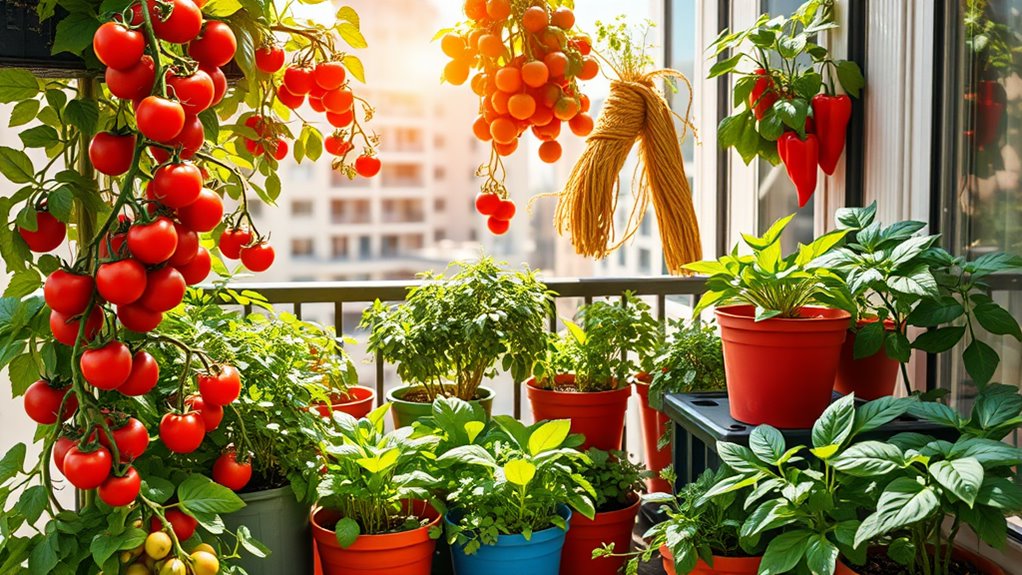Turn Your Balcony Into a Mini Farm With These Vegetable Picks
You can transform your balcony into a thriving mini farm by starting with space-saving veggies like cherry tomatoes, spinach, lettuce, and radishes, which yield quickly in pots. Use a well-draining soil mix with compost and perlite for ideal growth, and add trellises for climbing plants. Water deeply in the morning and check regularly for pests like aphids. You’ll discover more strategies to boost your yields and savor fresh harvests all season.
Top Vegetables for Balcony Spaces
When you’re setting up a balcony garden, focus on compact vegetables that thrive in limited space and varying light conditions.
In urban vegetable gardening, top choices include cherry tomatoes, which offer high yields in small pots; spinach, tolerating shade while providing nutrients; lettuce, growing quickly for fresh salads; radishes, ready in a month; and compact peppers, perfect for balcony containers. Additionally, consider incorporating fast-growing salad greens that can provide a continuous harvest throughout the season.
Space-Saving Planting Strategies
How can you maximize your balcony’s limited space while growing vegetables?
Install trellises for climbing plants like beans and peas, directing growth upward to free floor area.
Hang baskets for compact veggies such as cherry tomatoes or herbs, utilizing vertical air space.
Practice intercropping by pairing fast-maturing lettuce with slower crops.
Use stackable or tiered containers to layer plants efficiently, making every inch productive. Additionally, consider suitable plant choices that thrive in limited sunlight to ensure a successful harvest.
Choosing the Ideal Soil Mix
Selecting the right soil mix is essential for your balcony vegetables to thrive, as it directly influences root health and nutrient uptake.
You need a well-draining blend with organic matter like compost for nutrients and perlite for aeration.
Aim for a pH of 6.0 to 7.0 to optimize growth—test it first.
Avoid dense soils that compact easily, ensuring your plants get the best foundation for strong roots. Additionally, using a well-draining blend is crucial, as it prevents waterlogging and encourages healthy root development.
Essential Care and Watering Tips
Proper care and watering keep your balcony vegetables thriving, starting with consistent moisture checks to prevent root stress.
You’ll need to water deeply when the top inch of soil feels dry, ensuring even distribution for healthy roots.
Adjust frequency based on weather—hotter days demand more hydration.
Use mulch to retain moisture, and always apply water in the morning to minimize evaporation and support growth. Additionally, consider effective watering tips to further enhance your garden’s water efficiency.
Managing Pests and Diseases
Even though your balcony vegetables thrive with proper care, pests and diseases can still strike, so you’ll need to stay vigilant and act quickly. Regularly inspect leaves for early signs like spots or insects; use organic controls first. Here’s a practical guide:
| Pest/Disease | Symptoms | Control Action |
|---|---|---|
| Aphids | Curled leaves | Apply neem oil spray |
| Powdery Mildew | White patches | Improve ventilation |
| Spider Mites | Fine webbing | Wipe with soapy water |
Monitor weekly for best results. Additionally, using natural pest control methods can help protect your garden while maintaining a healthy ecosystem.
Harvesting and Storing Your Yield
Once your balcony vegetables reach peak ripeness, harvest them promptly to capture their full flavor and nutrients.
Use sharp shears for clean cuts to avoid damage, and pick early morning for crispness.
Store leafy greens in the fridge’s crisper drawer, wrapped in damp cloths; root veggies like carrots in a cool, dark spot.
Freeze excess for later use, labeling dates to maintain quality.
Always check for spoilage regularly.

